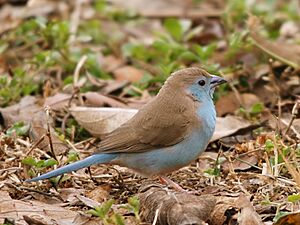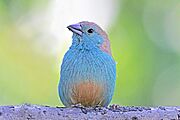Blue waxbill facts for kids
Quick facts for kids Blue waxbill |
|
|---|---|
 |
|
 |
|
| Male above and female below | |
| Conservation status | |
| Scientific classification | |
| Synonyms | |
|
Fringilla angolensis Linnaeus, 1758 |
The blue waxbill (Uraeginthus angolensis) is a small, colorful bird found in Southern Africa. It's also known by other names like the southern blue waxbill or blue-breasted waxbill. These birds are a type of estrildid finch, which are small, seed-eating birds. Blue waxbills are quite common in the wild and are also often kept as pet birds in aviaries.
Contents
About the Blue Waxbill's Name
The blue waxbill was first officially described in 1758 by a Swedish scientist named Carl Linnaeus. He gave it the scientific name Fringilla angolensis in his famous book, Systema Naturae. Linnaeus learned about this bird from drawings and descriptions made by an English naturalist, George Edwards. Edwards had seen a blue waxbill that came from Angola.
Later, in 1851, a German bird expert named Jean Cabanis placed this bird into a new group, or genus, called Uraeginthus. This is why its full scientific name today is Uraeginthus angolensis.
Different Types of Blue Waxbills
There are three main types, or subspecies, of the blue waxbill. They look very similar but live in slightly different areas:
| Image | Subspecies | Where They Live |
|---|---|---|
 |
U. a. angolensis – (Linnaeus, 1758) | São Tomé, southwest DR Congo, north Angola, and northwest Zambia |
 |
U. a. cyanopleurus – Wolters, 1963 | south Angola, southwest Zambia, northwest Zimbabwe, and north Botswana |
 |
U. a. niassensis – Reichenow, 1911 | east Tanzania to central, east Zambia, Malawi, Mozambique, south Zimbabwe, and east South Africa |
What Blue Waxbills Look Like
Blue waxbills are small birds, about 12 to 13 centimeters (around 5 inches) long. The male blue waxbill is very striking. It has bright powder-blue feathers on its face, chest, and sides. Its back and wings are a pale brown color.
The female blue waxbill is a bit different. She is usually paler than the male. Her blue color is mostly on her tail, head, and upper chest. The rest of her underside is a light brown color.
When they call, blue waxbills make a soft 'seee-seee' sound. You can often hear them repeating this call as they fly through bushes and low plants.
Where Blue Waxbills Live
Blue waxbills live across a large part of southern Africa. You can find them from areas like Cabinda Province and the Republic of the Congo in the west, all the way to Kenya and Tanzania in the east. They also live south into northern South Africa. Some blue waxbills might have been brought to islands like São Tomé Island and Zanzibar.
These birds can live in many different places. They especially like areas with good water and dry grasslands, known as savanna. They are often found where Vachellia tortilis trees (also called umbrella thorns) grow. You might also see them in gardens, on farms, or at the edges of forests.
How Blue Waxbills Live
Building Nests and Raising Families
Both the male and female blue waxbill work together to build their nest. Their nest is shaped like an oval with a small tunnel entrance on the side. They build it using grass stems and flower parts, and they line the inside with soft feathers.
Blue waxbills usually place their nests hidden among the leaves of a bush or tree. They especially like umbrella thorn trees and sickle bush plants. Interestingly, they often choose to build their nests close to a wasp nest. Scientists think this might be because the birds use the wasp nests as a sign that there are no harmful ants in the tree that could bother their babies. Blue waxbills might also use old nests built by other birds, sometimes even building their own nest right on top of an old one.
Blue waxbills can breed all year round. However, they lay most of their eggs in January, which is about two months after the rainy season starts in southern Africa. A female blue waxbill usually lays between 2 and 7 eggs. Both parents take turns sitting on the eggs, which hatch after about 11 to 12 days.
Once the chicks hatch, both parents feed them. They give their babies green grass seeds and small insects like termites. The young birds stay in the nest for about 17 to 21 days before they are ready to fly. A week after they leave the nest, they can find food for themselves. They become fully independent a week after that.
What Blue Waxbills Eat
Blue waxbills mostly eat grass seeds. They pick the seeds directly from the grass flowers. They also eat termites and other small insects to add to their diet. Sometimes, they have been seen eating fallen fruits from the Boscia albitrunca tree.
You will usually see blue waxbills in pairs or small family groups. However, they can also form larger flocks, especially when looking for food. These flocks often mix with groups of other types of finches.



